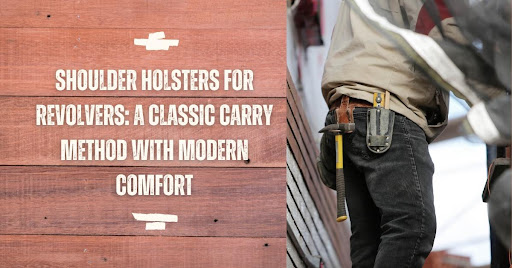A Shoulder Holster: What Is It?
The traditional choice, shoulder holsters, are ones you’ve seen on television and in movies like Dirty Harry and Miami Vice’s Sonny Crockett. They are more than just a stylish option; they also serve a functional purpose. With two straps you wear over your shoulder like a backpack, these holsters typically have a similar design. Depending on your preferred drawing position, you can have your gun mounted to a strap on either the right or left side or sometimes both.
Thanks to its relatively high mounting position, you can hide your handguns underneath your jacket or other loose clothing. According to many gun owners, this kind of holster offers a lot more comfort and security than the conventional IWB or OWB options. They are particularly popular with people who spend their days behind the wheel or seated at desks. Additionally, they can accommodate bigger handguns that are difficult to conceal in pockets or other holster systems.
The benefits and drawbacks of shoulder holsters
Modern shoulder holster systems are a great option for concealed carry because they offer comfort, functionality, and retention. The different advantages of shoulder holsters include the following:
- The gun’s weight is supported by your back and shoulders rather than just your belt, making it possible for you to wear it comfortably.
- You can keep magazine pouches on the holster’s opposite side.
- For seasoned users, it can deliver a draw relatively quickly.
- Unlike other IWB or OWB options, they can accommodate larger handguns, partly because they distribute the weapon’s weight over a larger portion of the body.
- Adaptable to a variety of body types.
- Best for driving because a shoulder holster provides ready access and is not obstructed by a seat belt.
Some shoulder holster designs are not suitable for everyone. The following are some of the drawbacks of shoulder holsters:
- First-time concealed carry users might need help finding this the best option.
- Compared to hip holsters, it requires a little more learning to fit the holster to your body and shape properly.
- Drawing your pistol can be challenging or awkward because you have to do a horizontal sweep, pointing the gun at anyone nearby if they are present.
- It does not provide adequate concealment when wearing more fitted clothing and calls for bulkier shirts or jackets.
- Certain rigs may conflict with shoulder straps.
- Many manufacturers will only accept a return if they have been used for a little while.
Which Holster Is Best for Concealed Carry?
The best holster for concealed carry is entirely a matter of preference. A holster might fit like a glove for one person, but for another, it might be extremely uncomfortable. Gun owners are fortunate to have a variety of holster options to choose from. Ultimately, concealed carry holsters should have the qualities listed below:
- Fit
- Retention
- Concealability
- Protection
- Function
- Comfort
In addition to finding the ideal holster, there are some factors in your control to ensure you get a good fit, such as the clothing you wear, your way of life, and the type of gun you own. If you can find a holster that fits you properly, which may require some trial-and-error, shoulder holsters, in particular, can be a great option for concealed carry. The ideal shoulder holster can perfectly complement your body and style.
Considerations for Choosing a Shoulder Holster
You should take into account the following factors in addition to its style:
Type of Gun
Starting with the appropriate handguns for this type of carry is one of the most critical steps in selecting the best shoulder holster. Uncomfortable carrying is made possible by a too-big gun that may ride up into your armpit. It would help to have a weapon that rides close to your body to avoid discomfort or printing. With the proper covering garment and depending on how it sits next to the body, shoulder holsters also function well with long-barreled handguns.
Fit/Comfort
If you do not get a snug fit, you risk having a holster that rides too high in your armpit and prevents the gun from fitting. Or it may ride too low, catching your ribs. Additionally, the concealability of the handgun may be impacted by its orientation. Find a holster with adjustable parts to make it fit your body.
Mobility
Test out your holster’s range of motion. The manufacturer’s warranty or return policy might be all you have to rely on.
Material
The most popular materials are nylon, leather, and Kydex, each with advantages and disadvantages. Even after years of use, Kydex retains its shape and is lightweight, but it does produce a slightly noisier draw than other materials. Leather is incredibly flexible, comfortable, and quiet but can deteriorate over time, especially if exposed to moisture. While not as durable as other materials, nylon is inexpensive and has a soft draw.
Retention
If your holster doesn’t have the right retention, you may be unable to keep your weapon in place during difficult movements like hand-to-hand combat, or it may fall out while riding a bike over bumps.
Concealment
When carrying a handgun openly is prohibited, concealment helps keep it hidden. Think about whether your shoulder holster hangs too high or too low so that it is visible by printing on your shirt or jacket.
Price
One-size-fits-all shoulder holster models can be less expensive, while custom options can cost more but provide the durability you need rather than forcing you to buy multiples because one breaks or does not fit properly.
Conclusion
Even when the weight is evenly across your shoulders, it can feel awkward and strain your back over the day to carry all the weight on one side. To ensure the harness is balanced, shoulder holsters have a calibrated counterweight on the opposite side.
The information in the blog was useful for you all. Do let us know in the comment section below.
